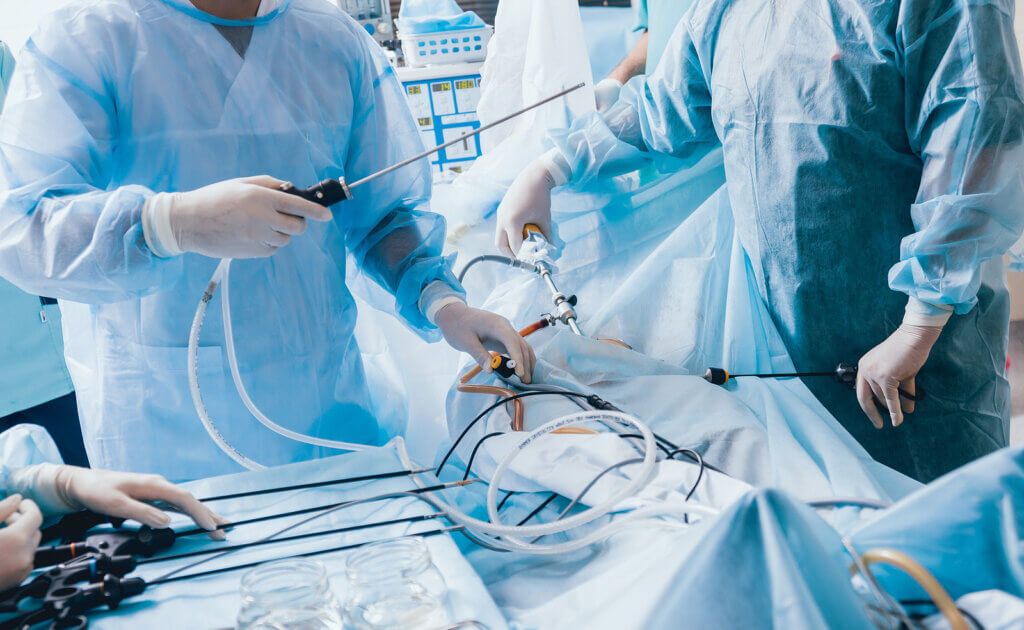The 3 Types of Anesthesia and Their Characteristics

Anesthesia is a technique that seeks to avoid the transmission of pain in one or more parts of the body. The main objective of it is to avoid discomfort during the performance of a medical or surgical intervention. In this regard, health personnel can use different types of anesthesia that adapt to the procedure to be performed.
Inhibition of pain transmission is achieved through the administration of substances known as anesthetics. The means of using these compounds are very varied, from topical to intravenous.
All anesthetics act on the nervous system, blocking the transmission of the impulse that will carry the information corresponding to pain. The mechanism of action of these medications will vary depending on the compound and the types of anesthesia used.
Types of anesthesia
Today there are 3 different types of anesthesia. They’re used in the application of sutures or in minor dental procedures. Anesthesia is also useful in medical tests, such as colonoscopy, or in major surgeries, such as organ transplantation.
1. General anesthesia
General anesthesia is a technique that uses different medications and is capable of inducing a state similar to sleep in people. Patients don’t feel pain because they’re unconscious and the brain doesn’t respond to the signals sent. It’s used in very complex medical procedures, such as cardiovascular, brain, or transplant surgeries.
General anesthetics are administered intravenously or through inhalation of gases with a mask. Unlike the other types of anesthesia, general anesthesia combines different drugs to obtain greater benefits and reduce side effects.
Among the compounds that can be used, the following stand out:
- Halogenated anesthesia
- Psychopharmaceuticals such as benzodiazepines and barbiturates.
- Ketamine
- Cyclopropane
- Muscle relaxants
- Opioids
- Propofol
General anesthesia is given by a specialized doctor called an anesthesiologist. The specialist will be in charge of monitoring vital signs during the operation and will also help in the post-surgery awakening process.
General anesthesia is relatively safe, however, multiple studies show that some people can have disorders in various organs. In this regard, those with cardiovascular, kidney, or lung diseases should exercise caution.

2. Regional anesthesia
Regional anesthesia consists of the administration of anesthetics that will block the transmission of pain in a specific region of the body. This type is capable of acting in large regions, such as an arm, a leg, or below the waist. The main difference from general anesthesia is that people are conscious.
Regional anesthesia is very useful for treating chronic pain and for minor procedures such as childbirth or cesarean section. In addition, it’s the perfect option for those at risk of presenting harmful effects from general anesthesia.
Regional anesthetics are given through an injection near the spine or down the path of a nerve. The main mechanism of action of these drugs is the blocking of the ion channels of the cells. This inhibition will prevent the person from feeling pain.
Generally speaking, regional anesthesia is much safer than general anesthesia. Multiple investigations show that the probability of developing respiratory complications is lower. In addition, the postoperative recovery time decreases.
3. Local anesthesia
Local anesthesia is one of the most widely used types of anesthesia worldwide. It allows for the inhibition of the transmission of pain in a very small area of the body. The main reference regarding regional anesthesia is the radius of action, which is much smaller in comparison.
People often remain conscious during local anesthesia, so it’s especially helpful in outpatient procedures. It’s very useful when stitches must be placed in a wound or in dental treatments. It also serves in the treatment of diseases that involve acute pain, such as hemorrhoids.
Local anesthetics can be administered through subcutaneous injections or topically when included in eye drops and ointments. One of the most widely used drugs in this group is lidocaine, which exerts its effect quickly and can last more than 1 hour.
The possibility of developing adverse effects is very low, making it one of the safest types of anesthesia of all. The most common adverse effect is increased bleeding at the administration site.

Multiple types of anesthesia with different goals
The types of anesthesia existing today are adapted to any surgical procedure that you want to perform. General anesthesia is used in major surgeries, while regional anesthesia is used in less complex interventions. Finally, local anesthesia is the technique of choice in simple, fast, and minimally invasive procedures.
Anesthesia is a technique that seeks to avoid the transmission of pain in one or more parts of the body. The main objective of it is to avoid discomfort during the performance of a medical or surgical intervention. In this regard, health personnel can use different types of anesthesia that adapt to the procedure to be performed.
Inhibition of pain transmission is achieved through the administration of substances known as anesthetics. The means of using these compounds are very varied, from topical to intravenous.
All anesthetics act on the nervous system, blocking the transmission of the impulse that will carry the information corresponding to pain. The mechanism of action of these medications will vary depending on the compound and the types of anesthesia used.
Types of anesthesia
Today there are 3 different types of anesthesia. They’re used in the application of sutures or in minor dental procedures. Anesthesia is also useful in medical tests, such as colonoscopy, or in major surgeries, such as organ transplantation.
1. General anesthesia
General anesthesia is a technique that uses different medications and is capable of inducing a state similar to sleep in people. Patients don’t feel pain because they’re unconscious and the brain doesn’t respond to the signals sent. It’s used in very complex medical procedures, such as cardiovascular, brain, or transplant surgeries.
General anesthetics are administered intravenously or through inhalation of gases with a mask. Unlike the other types of anesthesia, general anesthesia combines different drugs to obtain greater benefits and reduce side effects.
Among the compounds that can be used, the following stand out:
- Halogenated anesthesia
- Psychopharmaceuticals such as benzodiazepines and barbiturates.
- Ketamine
- Cyclopropane
- Muscle relaxants
- Opioids
- Propofol
General anesthesia is given by a specialized doctor called an anesthesiologist. The specialist will be in charge of monitoring vital signs during the operation and will also help in the post-surgery awakening process.
General anesthesia is relatively safe, however, multiple studies show that some people can have disorders in various organs. In this regard, those with cardiovascular, kidney, or lung diseases should exercise caution.

2. Regional anesthesia
Regional anesthesia consists of the administration of anesthetics that will block the transmission of pain in a specific region of the body. This type is capable of acting in large regions, such as an arm, a leg, or below the waist. The main difference from general anesthesia is that people are conscious.
Regional anesthesia is very useful for treating chronic pain and for minor procedures such as childbirth or cesarean section. In addition, it’s the perfect option for those at risk of presenting harmful effects from general anesthesia.
Regional anesthetics are given through an injection near the spine or down the path of a nerve. The main mechanism of action of these drugs is the blocking of the ion channels of the cells. This inhibition will prevent the person from feeling pain.
Generally speaking, regional anesthesia is much safer than general anesthesia. Multiple investigations show that the probability of developing respiratory complications is lower. In addition, the postoperative recovery time decreases.
3. Local anesthesia
Local anesthesia is one of the most widely used types of anesthesia worldwide. It allows for the inhibition of the transmission of pain in a very small area of the body. The main reference regarding regional anesthesia is the radius of action, which is much smaller in comparison.
People often remain conscious during local anesthesia, so it’s especially helpful in outpatient procedures. It’s very useful when stitches must be placed in a wound or in dental treatments. It also serves in the treatment of diseases that involve acute pain, such as hemorrhoids.
Local anesthetics can be administered through subcutaneous injections or topically when included in eye drops and ointments. One of the most widely used drugs in this group is lidocaine, which exerts its effect quickly and can last more than 1 hour.
The possibility of developing adverse effects is very low, making it one of the safest types of anesthesia of all. The most common adverse effect is increased bleeding at the administration site.

Multiple types of anesthesia with different goals
The types of anesthesia existing today are adapted to any surgical procedure that you want to perform. General anesthesia is used in major surgeries, while regional anesthesia is used in less complex interventions. Finally, local anesthesia is the technique of choice in simple, fast, and minimally invasive procedures.
- Alizadeh R, Fard ZA. Renal effects of general anesthesia from old to recent studies. J Cell Physiol. 2019 Aug;234(10):16944-16952.
- Senhadji L, Wodey E, Claude E. Monitoring approaches in general anesthesia: a survey. Crit Rev Biomed Eng. 2002;30(1-3):85-97.
- Pincus E. Regional Anesthesia: An Overview. AORN J. 2019 Sep;110(3):263-272.
- Lin C, Darling C, Tsui BCH. Practical Regional Anesthesia Guide for Elderly Patients. Drugs Aging. 2019 Mar;36(3):213-234.
- Klingberg G, Ridell K, Brogårdh-Roth S, Vall M, Berlin H. Local analgesia in paediatric dentistry: a systematic review of techniques and pharmacologic agents. Eur Arch Paediatr Dent. 2017 Oct;18(5):323-329.
- Dickerson DM, Apfelbaum JL. Local anesthetic systemic toxicity. Aesthet Surg J. 2014 Sep;34(7):1111-9.
Este texto se ofrece únicamente con propósitos informativos y no reemplaza la consulta con un profesional. Ante dudas, consulta a tu especialista.







